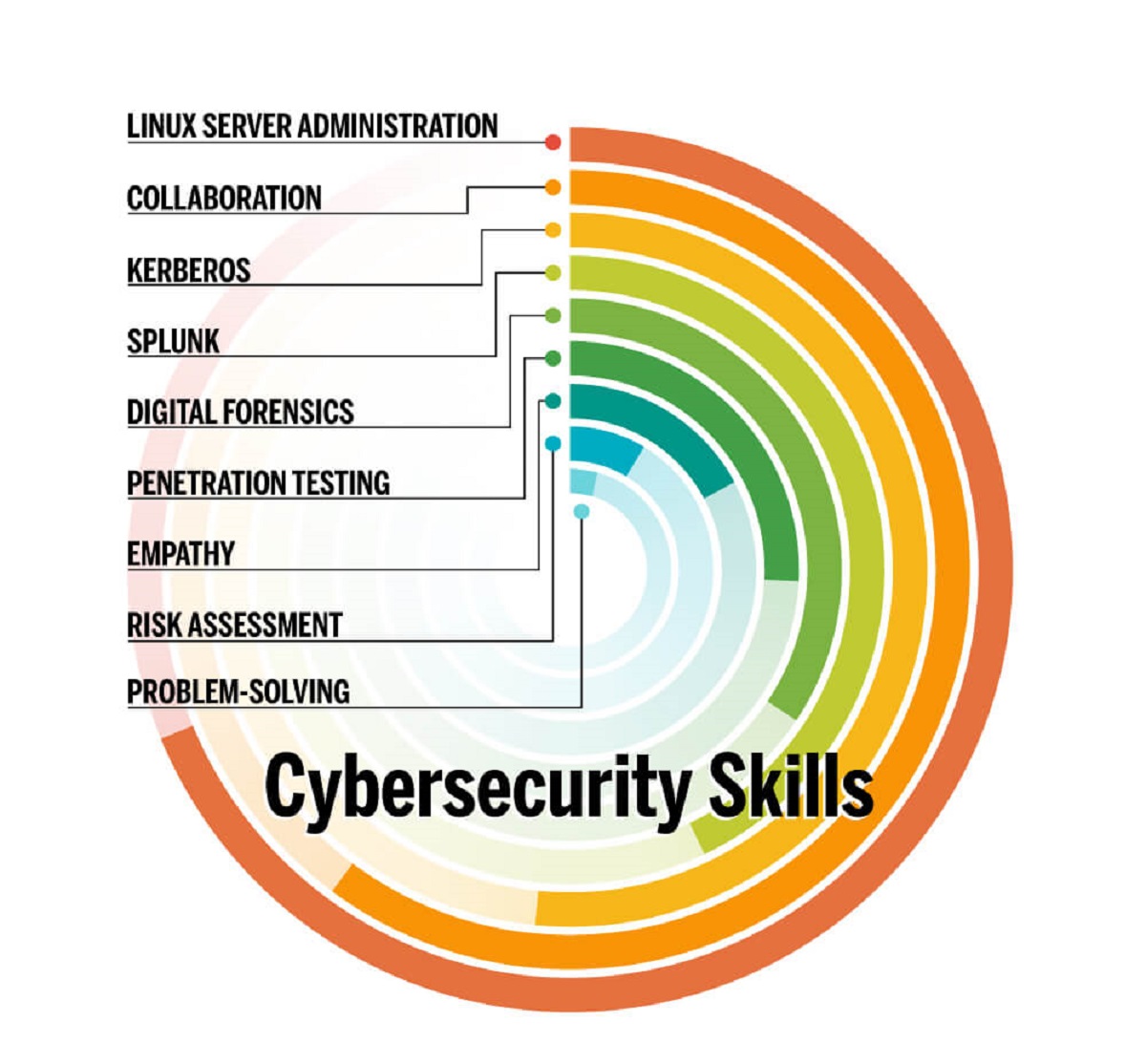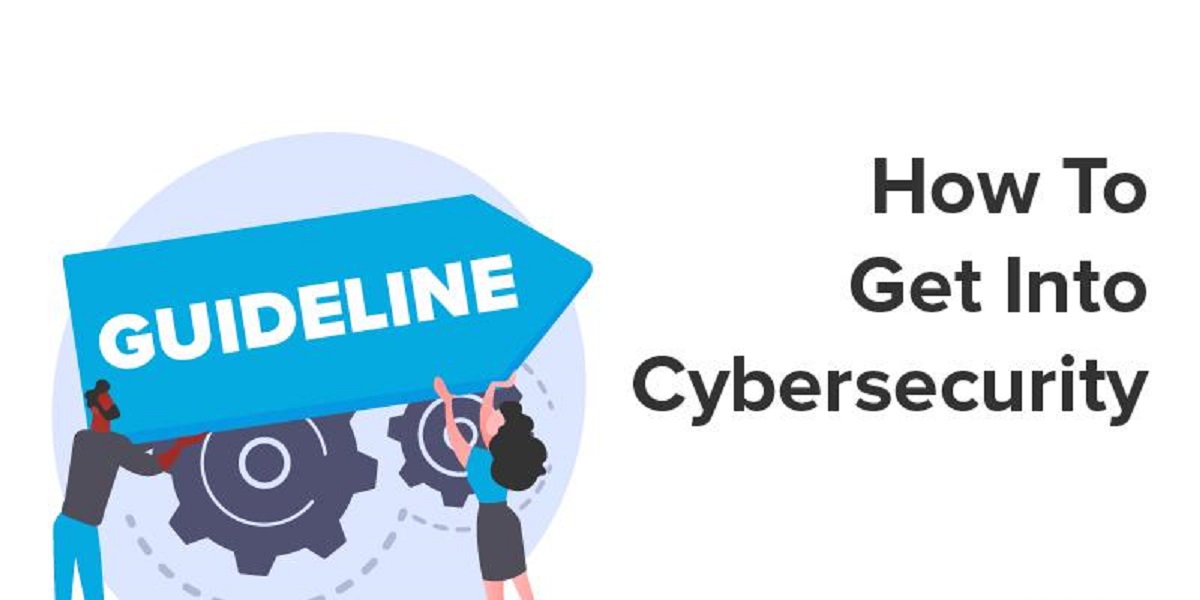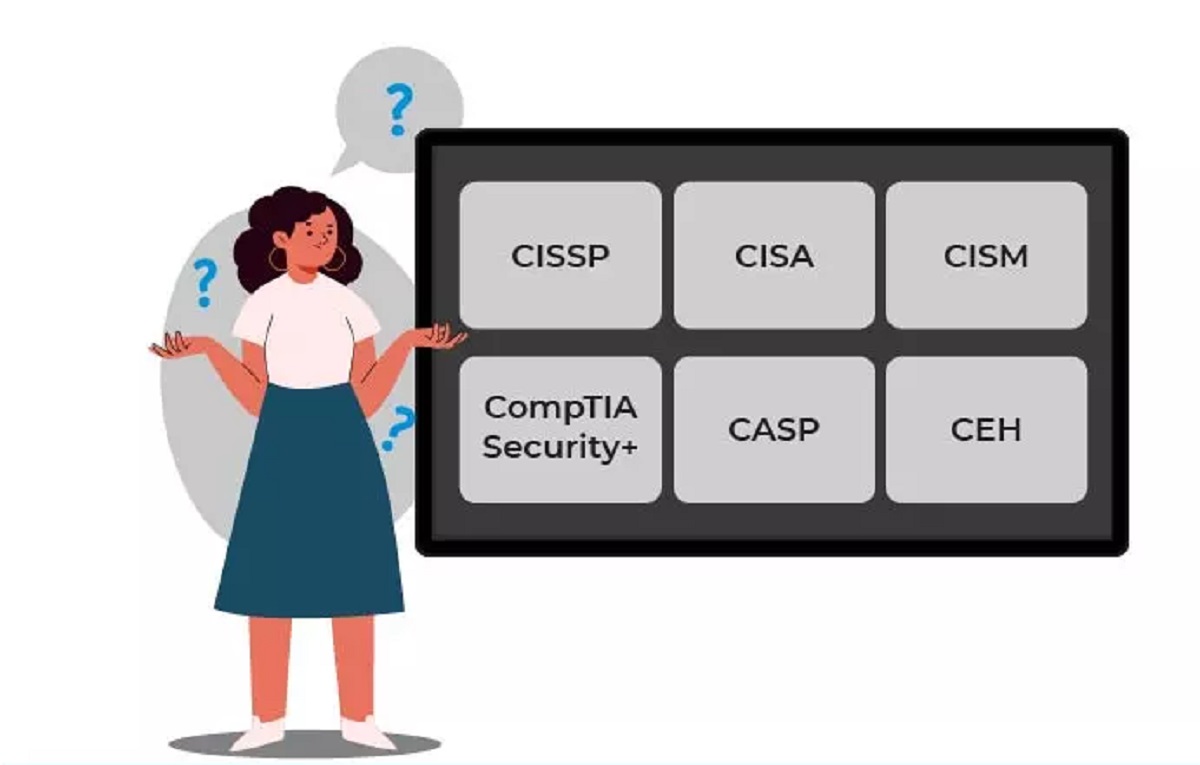Introduction
Welcome to the world of cybersecurity! In today’s digital landscape, where technology is increasingly intertwined with our daily lives, protecting sensitive information has become more crucial than ever. Cybersecurity plays a vital role in safeguarding data, networks, and systems from unauthorized access, attacks, and potential threats.
In this article, we will explore the skills necessary to enter the field of cybersecurity and become a successful cybersecurity professional. Whether you are considering a career switch or just getting started, understanding the essential technical and soft skills required in this field is key to your success.
With the growing prevalence of cyber attacks and the ever-increasing reliance on digital platforms, organizations across industries are prioritizing cybersecurity to safeguard their systems and data. This trend has resulted in a high demand for skilled cybersecurity professionals who can navigate the complex and ever-evolving threat landscape.
Before we delve into the specific technical and soft skills required for a career in cybersecurity, it’s important to recognize the multifaceted nature of this field. Cybersecurity encompasses various domains, including network security, system administration, secure coding, incident response, threat intelligence, penetration testing, and more.
Acquiring the right blend of technical and soft skills is crucial for success in the field of cybersecurity. While technical skills provide the necessary foundation to handle the technical aspects of cybersecurity, soft skills complement these abilities by enabling effective communication, critical thinking, and problem-solving.
Throughout this article, we will explore the key technical and soft skills needed to excel in the field of cybersecurity. By acquiring and honing these skills, you will be equipped to face the dynamic challenges of cybersecurity head-on and contribute to the protection of valuable information in today’s digitally-driven world.
Understanding Cybersecurity
Cybersecurity is the practice of protecting computer systems, networks, and data from unauthorized access, theft, damage, or disruption. It involves implementing measures and protocols to prevent cyber threats and to respond effectively in the event of an incident.
One of the fundamental concepts in cybersecurity is the CIA triad, which stands for Confidentiality, Integrity, and Availability. Confidentiality ensures that data is only accessible to authorized individuals or systems. Integrity ensures that data remains accurate and unchanged. Availability ensures that systems and data are accessible when needed.
There are various types of cyber threats that individuals and organizations face, ranging from malware and phishing attacks to ransomware and data breaches. Cybercriminals use sophisticated techniques to exploit vulnerabilities in systems and gain unauthorized access to sensitive information.
In addition to external threats, internal threats also pose a significant risk to cybersecurity. Insider threats can come from employees, contractors, or anyone with authorized access to systems and data. These threats can result from negligence, malicious intent, or accidental disclosure.
When it comes to cybersecurity, prevention, detection, and response are equally important. Implementing robust security measures, such as firewalls, encryption, and access controls, can help prevent unauthorized access and attacks. Detection mechanisms, such as intrusion detection systems and security monitoring, can identify suspicious activities and potential threats. Additionally, having an incident response plan in place can help minimize the impact of a security breach and facilitate a prompt and organized response.
As technology continues to advance, new challenges emerge in the field of cybersecurity. The rise of Internet of Things (IoT) devices, cloud computing, and artificial intelligence has brought about new vulnerabilities and potential entry points for cyber attacks. Therefore, staying updated on the latest security trends, best practices, and emerging technologies is essential for cybersecurity professionals.
Understanding the fundamental concepts and principles of cybersecurity is the first step to building a successful career in this field. It provides a solid foundation for acquiring the necessary technical skills and enables professionals to effectively address the ever-changing landscape of cyber threats.
Technical Skills Needed for Cybersecurity
Working in cybersecurity requires a strong foundation of technical skills to protect systems and data from cyber threats. Let’s explore some key technical skills that are essential for a successful career in cybersecurity:
- Network Security: Understanding network protocols, firewalls, routers, and VPNs is crucial for securing network infrastructure and preventing unauthorized access.
- Programming and Scripting: Proficiency in languages like Python, C++, and PowerShell is essential for analyzing, automating tasks, and developing security tools.
- Secure Coding Practices: Knowledge of secure coding practices helps in developing software with fewer vulnerabilities and reduces the likelihood of successful attacks.
- System Administration: Having expertise in system administration allows you to configure and manage security infrastructure, apply patches, and secure operating systems.
- Cryptography: Understanding cryptographic algorithms, encryption, and decryption techniques helps ensure the confidentiality and integrity of sensitive information.
- Incident Response: Being familiar with incident response frameworks and tools enables effective detection, analysis, containment, and recovery in the event of a security incident or breach.
- Threat Intelligence: Keeping abreast of the latest cyber threats and understanding threat intelligence tools and techniques helps in proactive identification and mitigation of potential risks.
- Security Assessment and Penetration Testing: Proficiency in performing security assessments, vulnerability scanning, and penetration testing helps identify vulnerabilities and weaknesses in systems before they are exploited.
- Secure Software Development: Understanding secure software development practices, such as secure coding, secure APIs, and secure SDLC, allows for building robust and resilient software systems.
- Forensics and Reverse Engineering: Knowledge of digital forensics techniques and reverse engineering helps investigate security incidents, analyze malware, and identify potential vulnerabilities.
These technical skills provide the foundation for building a successful career in cybersecurity. As technology advances and new cyber threats emerge, it is important to continuously update and expand your technical skillset to stay ahead of the challenges in the ever-evolving landscape of cybersecurity.
Network Security
Network security is a critical aspect of cybersecurity that involves protecting computer networks from unauthorized access, misuse, and malicious activities. It focuses on securing the underlying infrastructure and ensuring the confidentiality, integrity, and availability of network resources and data.
To excel in network security, professionals need to possess the following skills:
- Understanding Network Protocols: Proficiency in network protocols such as TCP/IP, HTTPS, HTTP, and DNS is essential for identifying and mitigating network-based vulnerabilities.
- Firewalls and Routers: Knowledge of firewalls and routers helps in implementing access controls, configuring secure connections, and preventing unauthorized access to networks.
- Virtual Private Networks (VPNs): Competence in VPN technologies enables the secure transmission of data over public networks, ensuring confidentiality and privacy.
- Network Segmentation: Understanding network segmentation techniques allows for dividing networks into logical segments to minimize the impact of security breaches and contain potential threats.
- Intrusion Detection Systems (IDS) and Intrusion Prevention Systems (IPS): Familiarity with IDS and IPS tools enables the detection and prevention of unauthorized access and suspicious activities on networks.
- Wireless Network Security: Knowledge of wireless network security protocols, such as WPA2 and EAP, helps safeguard wireless networks from unauthorized access and eavesdropping.
- Vulnerability Management: Proficiency in vulnerability scanning and assessment tools helps identify and mitigate weaknesses in network infrastructure before they are exploited by attackers.
Network security professionals play a crucial role in safeguarding the systems, applications, and data that rely on network connections. Their expertise in securing networks ensures that organizations can operate safely and maintain the confidentiality and integrity of their data.
With the increasing sophistication of cyber attacks and the expanding use of the internet, network security is a constantly evolving field. Keeping up with the latest trends, emerging technologies, and best practices in network security is essential for professionals in this domain.
Programming and Scripting
Proficiency in programming and scripting languages is a crucial skill set for cybersecurity professionals. It empowers them to automate tasks, analyze data, and develop security tools that enhance the overall security posture. Let’s explore the importance of programming and scripting skills in cybersecurity:
1. Automation and Task Efficiency: Programming languages like Python, C++, and PowerShell enable professionals to automate repetitive tasks and streamline processes. This not only saves time but also reduces the risk of errors and vulnerabilities caused by manual interventions.
2. Data Analysis and Visualization: Programming skills allow cybersecurity experts to analyze large datasets, identify patterns, and detect anomalies. By utilizing libraries and frameworks like pandas, numpy, and matplotlib, professionals can visualize data and gain insights into potential security threats or vulnerabilities.
3. Development of Security Tools: With programming knowledge, professionals can develop customized security tools to address specific security challenges. This includes creating scripts for vulnerability scanning, network monitoring, and log analysis.
4. Malware Analysis: Malware is a pervasive threat in the cybersecurity landscape. Proficiency in scripting languages like Python and knowledge of assembly language can facilitate the analysis of malware and the identification of its behavior, allowing for appropriate countermeasures.
5. Web Application Security: Understanding programming languages and frameworks commonly used in web application development, such as HTML, JavaScript, PHP, and SQL, is crucial for identifying and exploiting vulnerabilities in web applications, as well as implementing secure coding practices.
6. Secure Coding: Knowledge of programming languages and secure coding practices is vital in developing software systems with fewer vulnerabilities. It enables the integration of security controls, input validation, and proper error handling, reducing the risk of successful attacks.
Programming and scripting skills empower cybersecurity professionals to enhance their capabilities and address complex security challenges effectively. Keeping up with the latest programming languages, frameworks, and security trends is crucial for staying ahead in the rapidly evolving field of cybersecurity.
Secure Coding Practices
Secure coding practices are integral to developing software systems with enhanced security and fewer vulnerabilities. Understanding and implementing these practices is crucial for cybersecurity professionals to ensure that applications and systems are resilient against attacks. Let’s explore the importance of secure coding practices in cybersecurity:
1. Input Validation: Properly validating and sanitizing user input is essential to prevent common vulnerabilities such as SQL injection, cross-site scripting (XSS), and command injection attacks. By implementing input validation techniques, such as parameterized queries and output encoding, developers can mitigate the risk of unauthorized data manipulation.
2. Secure Authentication and Authorization: Implementing strong authentication mechanisms, such as multi-factor authentication (MFA) and password hashing algorithms, helps protect user credentials and prevent unauthorized access. Additionally, incorporating proper authorization checks ensures that only authorized users can access specific resources or perform certain actions.
3. Data Encryption: Implementing encryption algorithms, such as AES (Advanced Encryption Standard), helps protect sensitive data at rest and in transit. Encryption assures the confidentiality and integrity of the data, even if it falls into the wrong hands. It is especially important when handling personally identifiable information (PII) or sensitive financial data.
4. Error Handling: Proper error handling practices assist in preventing information leakage and potential security vulnerabilities. By providing minimal error information to users and logging detailed error messages internally, developers can protect sensitive system details from being exposed to potential attackers.
5. Secure Configuration: Ensuring that systems and applications are configured securely is vital to prevent security breaches. This includes implementing secure defaults, disabling unnecessary services and features, and regularly updating and patching software components.
6. Secure APIs: Developers need to follow secure coding practices when designing and implementing application programming interfaces (APIs). This includes validating input, enforcing access controls, and protecting against common API vulnerabilities like injection attacks and privilege escalation.
By incorporating secure coding practices into software development processes, cybersecurity professionals can significantly reduce the risk of successful attacks. These practices not only mitigate vulnerabilities but also enhance data privacy and the overall security stance of applications and systems.
Staying updated with the latest security guidelines, threat landscape, and emerging vulnerabilities is essential for cybersecurity professionals to continually improve their secure coding practices and protect against evolving risks.
System Administration
System administration plays a crucial role in cybersecurity as it involves managing and securing the underlying infrastructure, operating systems, and network resources. Proficiency in system administration is essential for maintaining the integrity, availability, and security of computer systems. Let’s explore the importance of system administration skills in cybersecurity:
1. Configuration and Hardening: System administrators are responsible for configuring and hardening operating systems and network devices. This includes disabling unnecessary services, applying security patches, and implementing access control mechanisms to prevent unauthorized access and reduce the attack surface.
2. Log Management: Effective log management is essential for identifying and analyzing security incidents. System administrators ensure that logs are captured, stored securely, and regularly reviewed to detect any unusual activities or potential threats.
3. Backup and Recovery: Creating and maintaining backups of critical data and systems is vital for business continuity and resilience. System administrators implement robust backup and recovery strategies to ensure data can be restored in the event of a security incident or system failure.
4. Patch Management: Regularly applying security patches and updates to operating systems and software is crucial for addressing known vulnerabilities and reducing the risk of exploitation. System administrators oversee the patch management process to keep systems up to date and secure.
5. User and Access Management: System administrators are responsible for managing user accounts, access controls, and permissions to ensure that only authorized individuals have appropriate access to systems and resources. This includes implementing strong password policies, utilizing multi-factor authentication, and periodically reviewing user privileges.
6. Incident Response and Recovery: System administrators play a key role in incident response, helping to contain, analyze, and recover from security incidents. They work closely with incident response teams to investigate the root cause, mitigate the impact, and implement remediation measures.
System administrators play a critical role in maintaining the security posture of an organization. Their expertise in configuring, managing, and securing computer systems is essential for protecting sensitive information and ensuring the smooth operation of IT infrastructure.
As cybersecurity threats continue to evolve, system administrators need to stay updated with the latest security trends, best practices, and emerging technologies. Continuous learning and professional development are crucial to enhancing system administration skills and effectively addressing the evolving cybersecurity landscape.
Cryptography
Cryptography is the practice of securing communication and data by encoding it in such a way that only authorized individuals can access and understand it. It is a fundamental component of cybersecurity, ensuring the confidentiality, integrity, and authenticity of information. Let’s explore the importance of cryptography skills in cybersecurity:
1. Confidentiality: Cryptographic algorithms are designed to encrypt data, ensuring that it remains confidential and only accessible to authorized individuals. By encrypting sensitive information, such as passwords, financial data, or personal records, cybersecurity professionals can protect it from unauthorized access or disclosure in the event of a security breach.
2. Integrity: Cryptography provides mechanisms to ensure the integrity of data. By using techniques such as digital signatures and message authentication codes, cybersecurity professionals can detect any unauthorized modifications to data and validate its authenticity.
3. Authentication: Cryptographic techniques are employed to establish the identity of individuals or systems. Public key infrastructure (PKI) allows for secure authentication and validation of identities, helping prevent impersonation and unauthorized access.
4. Key Management: Cryptography involves the management of encryption keys used to encrypt and decrypt data. Effective key management practices ensure that keys are securely generated, distributed, stored, and revoked when necessary. This is essential for maintaining the security of encrypted data and preventing unauthorized access.
5. Secure Communication: Cryptographic protocols, such as Transport Layer Security (TLS) and Secure Shell (SSH), are used to secure communication channels and protect data transmitted over networks. By employing encryption algorithms and secure key exchange mechanisms, these protocols establish secure and trusted connections, ensuring the confidentiality and integrity of data during transit.
6. Cryptanalysis: Understanding the principles of cryptanalysis is crucial for cybersecurity professionals to assess the strength of cryptographic algorithms and protocols. This involves analyzing encryption algorithms to identify potential vulnerabilities or weaknesses that could be exploited by attackers.
As cybersecurity threats continue to evolve, cryptography remains a critical aspect of securing information. Cybersecurity professionals with expertise in cryptography play a vital role in implementing and maintaining secure cryptographic systems and protocols.
Staying abreast of the latest cryptographic algorithms, protocols, and emerging threats is essential for cybersecurity professionals to effectively leverage cryptography in protecting sensitive information in today’s digital landscape.
Incident Response
Incident response is a crucial aspect of cybersecurity that involves effectively detecting, analyzing, and responding to security incidents. It is the process of mitigating the impact of security breaches, identifying the root cause, and implementing remediation measures to prevent future incidents. Let’s explore the importance of incident response skills in cybersecurity:
1. Timely Detection: Incident response professionals are trained to identify and detect security incidents promptly. Early detection allows for a faster response and minimizes the potential damage caused by an attack.
2. Analysis and Investigation: Incident responders have the skills to analyze and investigate security incidents to determine the root cause, understand the extent of the breach, and assess the impact on systems and data. This analysis provides crucial insights for implementing appropriate remediation measures.
3. Containment and Mitigation: Incident response involves containing the incident to prevent further damage and mitigate the impact on systems and infrastructure. Responders work swiftly to isolate affected systems, neutralize threats, and limit the attacker’s access.
4. Forensics: Incident response professionals often employ forensic techniques to gather evidence and preserve a chain of custody. This evidence can be crucial for legal or disciplinary actions and for identifying gaps in the security controls that need to be addressed.
5. Communication and Reporting: Effective communication is key during an incident response. Professionals must liaise with stakeholders, including management, IT teams, legal departments, and law enforcement agencies, to provide timely updates and ensure a coordinated response.
6. Lessons Learned and Improvement: Following the resolution of a security incident, incident response professionals conduct thorough post-incident reviews to identify areas for improvement. These insights help organizations update their incident response plans, strengthen security defenses, and enhance their overall cybersecurity posture.
Incident response is an ongoing process that requires continual learning and adaptation. As new threats emerge and attack techniques evolve, incident response professionals must stay updated on the latest trends, tools, and best practices to effectively defend against and respond to security incidents.
A well-executed incident response plan can help organizations minimize financial losses, protect their reputation, and maintain the trust of customers and stakeholders in the face of a security breach.
Threat Intelligence
Threat intelligence is a crucial component of cybersecurity that involves collecting and analyzing data to gain insights into potential threats, vulnerabilities, and attack techniques. It helps organizations understand the evolving threat landscape and make informed decisions to protect their systems and data. Let’s explore the importance of threat intelligence skills in cybersecurity:
1. Proactive Defense: Threat intelligence enables proactive defense by providing early warnings and indicators of potential threats. By monitoring and analyzing threat intelligence feeds, cybersecurity professionals can anticipate and mitigate emerging risks before they become full-blown attacks.
2. Threat Monitoring and Detection: Threat intelligence assists in monitoring and detecting potential threats within an organization’s network or systems. By analyzing indicators of compromise (IOCs) and known attack patterns, cybersecurity professionals can identify and respond to suspicious activities promptly.
3. Understanding Attack Techniques: Threat intelligence provides insights into the latest attack techniques, tactics, and procedures (TTPs) used by cybercriminals. This knowledge helps organizations understand the potential risks they face and identify the appropriate defense mechanisms to mitigate them.
4. Identifying Vulnerabilities: Threat intelligence sheds light on vulnerabilities in systems, applications, or infrastructure that malicious actors may exploit. By leveraging this information, organizations can prioritize patch management efforts and implement appropriate security controls to reduce their exposure to potential attacks.
5. Contextualizing Threats: Threat intelligence helps organizations understand the context of threats by providing information about threat actors, their motivations, and their targets. This knowledge enables cybersecurity professionals to assess the relevance and severity of threats and tailor their defense strategies accordingly.
6. Sharing Information: Threat intelligence encourages the exchange of valuable information between organizations, industry sectors, and government agencies. By sharing information about threats and attack techniques, the collective knowledge and defenses of the cybersecurity community are enhanced, and the overall resilience against cyber threats is strengthened.
Staying updated on the latest threat intelligence and leveraging threat intelligence platforms and tools is essential for cybersecurity professionals. By incorporating threat intelligence into their strategies, organizations can effectively identify and respond to potential threats, enhancing their ability to detect, prevent, and mitigate cybersecurity incidents.
Threat intelligence is a dynamic field that requires continual monitoring, analysis, and adaptation to stay ahead of evolving threats. By integrating threat intelligence into their processes, cybersecurity professionals can gain a deeper understanding of the threat landscape and make informed decisions to protect their organization’s digital assets.
Security Assessment and Penetration Testing
Security assessment and penetration testing are critical activities in cybersecurity that help identify vulnerabilities and weaknesses in systems, applications, and networks. These techniques involve actively testing the security controls and defenses of an organization’s infrastructure to identify potential entry points for attackers. Let’s explore the importance of security assessment and penetration testing skills in cybersecurity:
1. Identifying Vulnerabilities: Security assessments and penetration testing help uncover vulnerabilities that may be unknown to the organization. By simulating real-world attacks and actively probing systems, cybersecurity professionals can identify weaknesses in configurations, software, or user practices.
2. Assessing Security Controls: Through security assessments, professionals evaluate the effectiveness of existing security controls, such as firewalls, intrusion detection systems, and access control mechanisms. They ensure that these controls are properly configured and functioning as intended.
3. Preventing Exploitation: Penetration testing enables cybersecurity professionals to identify potential methods of exploitation by attempting to breach systems and applications using known techniques. It helps organizations understand how vulnerable they are to various attack vectors and take appropriate measures to mitigate the identified risks.
4. Testing Incident Response: Combining security assessments with penetration testing allows organizations to test their incident response capabilities. By simulating real-world attack scenarios, organizations can evaluate the effectiveness of their response procedures and identify areas for improvement.
5. Compliance and Regulatory Requirements: Security assessments and penetration testing support compliance with industry regulations and standards such as PCI-DSS, HIPAA, and ISO 27001. They help organizations demonstrate due diligence and ensure they meet the necessary security requirements.
6. Security Awareness: Undertaking security assessments and penetration testing raises awareness among employees about the importance of cybersecurity. It helps educate staff about potential risks and the role they play in maintaining a secure environment and following best practices.
By conducting security assessments and penetration testing regularly, organizations can proactively discover and address vulnerabilities, reducing the potential for successful attacks and data breaches. These activities contribute to an organization’s overall cybersecurity strategy and its ability to protect valuable assets and sensitive information.
Security assessment and penetration testing are dynamic fields that require continual learning, staying up to date with the latest attack techniques and emerging vulnerabilities. By leveraging these skills effectively, cybersecurity professionals can significantly enhance an organization’s security posture and minimize the risk of cyber threats.
Secure Software Development
Secure software development is an essential aspect of cybersecurity that focuses on building robust and resilient software systems with built-in security measures. It involves integrating secure coding practices, implementing security controls, and adhering to secure software development lifecycle (SDLC) processes. Let’s explore the importance of secure software development skills in cybersecurity:
1. Vulnerability Mitigation: Secure software development practices help identify and mitigate vulnerabilities early in the software development lifecycle. By following secure coding principles, such as input validation, output encoding, and proper error handling, developers can minimize the likelihood of successful attacks.
2. Secure APIs: Developing secure APIs is crucial for ensuring the security of data exchanged between different systems. By implementing proper authentication, access controls, and encryption, developers can protect against unauthorized access and data manipulation.
3. Secure Configuration: Configuring software systems securely is vital for preventing security breaches. Developers ensure that default settings and configurations are secure, unnecessary features are disabled, and sensitive information is appropriately protected.
4. Secure Coding Standards: Adhering to secure coding standards, such as OWASP Top Ten, CERT Secure Coding, or industry-specific guidelines, helps ensure that developers follow best practices and industry-accepted security measures throughout the software development process.
5. Third-Party Integration: Integrating third-party components and libraries introduces potential vulnerabilities. Developers should conduct security assessments of these components, regularly update them, and ensure they meet the organization’s security requirements.
6. Patch Management: Developing a robust patch management process is crucial for addressing security vulnerabilities in software systems. Developers should stay updated with the latest security patches and regularly apply them to fix software vulnerabilities.
Secure software development practices enhance the resilience and trustworthiness of software systems, protecting against potential security breaches and safeguarding sensitive information. By integrating security from the early stages of the software development lifecycle, organizations can minimize the risk of security incidents and data breaches.
Continuous learning and staying up to date with the latest secure coding practices, frameworks, and security vulnerabilities are essential for developers to effectively incorporate security measures into software systems. By doing so, developers contribute to the overall cybersecurity posture of organizations and help create a safer digital environment.
Forensics and Reverse Engineering
Forensics and reverse engineering play crucial roles in cybersecurity, helping professionals analyze and investigate security incidents, malware, and software vulnerabilities. These skills involve the systematic collection, examination, and analysis of digital evidence to understand the behavior of systems and malicious actors. Let’s explore the importance of forensics and reverse engineering skills in cybersecurity:
1. Digital Evidence Analysis: Forensic techniques enable cybersecurity professionals to collect and analyze digital evidence from compromised systems or incidents. By preserving and analyzing this evidence, investigators can reconstruct events, identify the root cause, and understand the impact of an incident.
2. Malware Analysis: Reverse engineering skills are vital for analyzing malware samples, deconstructing their code, and understanding their behavior. It helps in identifying their capabilities, creating signatures for detection, and developing mitigation strategies.
3. Identifying Attack Vectors: By reverse engineering and analyzing different attack vectors, such as network protocols, file formats, or software vulnerabilities, cybersecurity professionals gain insights into the techniques used by attackers. This knowledge helps in identifying weaknesses, developing countermeasures, and improving system defenses.
4. Incident Response Support: Forensic analysis provides crucial insights during incident response, helping professionals understand the sequence of events, determine the extent of a breach, and develop effective mitigation and remediation strategies.
5. Legal and Compliance: Forensics plays an important role in legal and compliance investigations. The collection and analysis of digital evidence help in prosecuting cybercriminals, resolving disputes, and ensuring compliance with industry regulations and laws.
6. Software Vulnerability Analysis: Reverse engineering techniques assist in identifying vulnerabilities in software and finding potential exploit vectors. By analyzing software code and binaries, security professionals can uncover weaknesses, recommend fixes, and contribute to secure software development practices.
Developing expertise in forensics and reverse engineering enhances the investigative and analytical capabilities of cybersecurity professionals. By understanding the techniques used by attackers and the vulnerabilities they exploit, professionals can better defend against and respond to security threats.
Forensics and reverse engineering are continually evolving fields, as attackers constantly develop new techniques and exploit emerging technologies. Continuous learning, staying up to date with the latest tools, and actively participating in the cybersecurity community are essential for professionals in these domains.
By leveraging forensics and reverse engineering skills effectively, cybersecurity professionals contribute to improving incident response, enhancing digital evidence collection, and strengthening defenses against cyber threats.
Soft Skills Needed for Cybersecurity
In addition to technical expertise, cybersecurity professionals require a range of soft skills to excel in their roles. These skills complement their technical knowledge and enable effective communication, collaboration, critical thinking, and adaptability. Let’s explore the importance of soft skills in the field of cybersecurity:
1. Analytical Thinking: Cybersecurity professionals need strong analytical skills to assess complex situations, analyze data, and identify patterns or anomalies. Analytical thinking helps professionals to identify potential threats, make informed decisions, and devise effective mitigation strategies.
2. Problem-Solving: Effective problem-solving skills are essential in cybersecurity. Professionals encounter new challenges and threats regularly, and the ability to think critically, identify root causes, and develop innovative solutions is crucial for resolving security issues.
3. Communication Skills: Cybersecurity professionals must have strong communication skills to convey complex technical information to non-technical stakeholders. Effective communication helps in collaborating with teams, reporting security incidents, and promoting security awareness among employees.
4. Teamwork and Collaboration: Collaboration is essential in cybersecurity, as professionals often work in teams to address security challenges. The ability to work well with others, contribute ideas, and collaborate effectively helps in a coordinated response to security incidents and the development of robust security strategies.
5. Adaptability and Continuous Learning: Cybersecurity is a rapidly evolving field, with new threats and technologies emerging constantly. Professionals must have an aptitude for learning, adapt quickly to changing circumstances, and stay updated with the latest trends, tools, and best practices in cybersecurity.
6. Ethical Considerations: Handling sensitive information and making decisions that impact security requires strong ethical standards. Cybersecurity professionals must demonstrate integrity, maintain confidentiality, and understand the ethical implications of their actions.
These soft skills are essential for cybersecurity professionals to effectively navigate the multifaceted challenges of the field. The combination of technical expertise and soft skills enables professionals to communicate effectively, think critically, collaborate with teams, and adapt to new threats and technologies.
As cybersecurity professionals engage with diverse stakeholders, such as colleagues, clients, or law enforcement agencies, the importance of these soft skills becomes evident. Developing and honing these skills is as crucial as building technical expertise, as they contribute to the overall effectiveness and professionalism of cybersecurity professionals.
Analytical Thinking
Analytical thinking is a key soft skill that is essential for cybersecurity professionals. It involves the ability to break down complex problems, analyze data, identify patterns, and make informed decisions based on logical reasoning and evidence. Let’s explore the importance of analytical thinking in the field of cybersecurity:
1. Threat Analysis: Analytical thinking enables cybersecurity professionals to assess and analyze the wide range of threats and potential risks that organizations face. By examining data, identifying trends, and understanding the behavior of malicious actors, professionals can better anticipate and respond to threats.
2. Incident Investigation: When a security incident occurs, analytical thinking is crucial for conducting in-depth investigations. Professionals must examine the available evidence, analyze logs and system data, and reconstruct events to determine the root cause of the incident and the extent of the impact.
3. Data & Log Analysis: Analytical thinking plays a vital role in analyzing large volumes of data and logs to identify anomalies or suspicious activities. By applying analytical techniques, professionals can spot trends, deviations, or indicators of compromise that could signal a potential security breach.
4. Risk Assessment: Analytical thinking is essential for evaluating and assessing risks within an organization’s systems and processes. By conducting risk assessments, cybersecurity professionals can identify vulnerabilities, potential attack vectors, and the potential impact of various threats.
5. Decision Making: Analytical thinking provides the foundation for effective decision making in cybersecurity. Professionals must weigh the available evidence, consider potential outcomes, and make informed decisions to mitigate risks, allocate resources, and implement security measures.
6. Proactive Defense: Analytical thinking helps cybersecurity professionals anticipate and predict potential threats before they occur. By analyzing historical data, industry trends, and intelligence feeds, professionals can identify emerging threats and vulnerabilities, allowing organizations to implement proactive defense strategies.
Analytical thinking enables cybersecurity professionals to approach problems and challenges with a logical and evidence-based mindset. It allows for informed decision making, proactive risk mitigation, and effective incident response. Through analytical thinking, professionals can better understand the evolving threat landscape and make data-driven recommendations to protect organizations from cyber threats.
Developing strong analytical thinking skills requires practice and a continual commitment to learning. By honing this skill, cybersecurity professionals can enhance their ability to identify and respond to emerging threats, ultimately contributing to the overall security and resilience of organizations.
Problem-Solving
Problem-solving is a fundamental soft skill that is highly valued in the field of cybersecurity. Cybersecurity professionals encounter complex challenges regularly, and the ability to effectively identify, analyze, and solve problems is crucial for success. Let’s explore the importance of problem-solving skills in the field of cybersecurity:
1. Incident Response: Cybersecurity professionals must quickly and efficiently analyze security incidents and develop appropriate response strategies. Problem-solving skills help professionals identify the root cause of the incident, mitigate its impact, and prevent similar incidents in the future.
2. Vulnerability Assessment: Assessing vulnerabilities in systems and networks requires a systematic problem-solving approach. Professionals must identify weaknesses, understand their impact, and recommend effective solutions to patch vulnerabilities and reduce potential risks.
3. Security Controls Implementation: Effective problem-solving skills are required to identify the most appropriate security controls to mitigate risks. Professionals must evaluate different options, weigh their pros and cons, and make informed decisions regarding the implementation of security measures.
4. Emerging Threats: Cyber threats evolve rapidly, and problem-solving skills are crucial for keeping pace with new and sophisticated attack techniques. By analyzing emerging threats, professionals can determine the potential impact and develop innovative solutions to counteract those threats.
5. Risk Management: Problem-solving skills are integral to managing risks effectively. Professionals must assess the likelihood and potential consequences of risks, analyze their impact on business operations, and develop strategies to mitigate those risks.
6. Complex Systems Analysis: Cybersecurity often involves securing complex systems and networks. Problem-solving skills help professionals break down complex systems into manageable components, analyze interactions and dependencies, and identify potential weaknesses and vulnerabilities.
Problem-solving skills empower cybersecurity professionals to approach challenges with a structured and logical mindset. By applying effective problem-solving techniques, professionals can identify and resolve issues efficiently, minimizing the impact of security incidents and strengthening the overall security posture of organizations.
Developing problem-solving skills requires a combination of technical knowledge, experience, and critical thinking abilities. By actively seeking opportunities to improve problem-solving skills and embracing a mindset of continuous learning, cybersecurity professionals can enhance their ability to tackle complex challenges effectively in the ever-changing landscape of cybersecurity.
Communication Skills
Effective communication skills are vital for cybersecurity professionals as they interact with various stakeholders, including team members, clients, executives, and non-technical personnel. Clear and concise communication helps to convey complex technical concepts, facilitate collaboration, and promote a strong cybersecurity culture. Let’s explore the importance of communication skills in the field of cybersecurity:
1. Reporting Security Incidents: Cybersecurity professionals must be able to clearly communicate security incidents to management, clients, and appropriate incident response teams. Effective reporting ensures that incidents are understood, prioritized, and resolved promptly.
2. Security Awareness Training: Communication skills are essential when conducting security awareness programs to educate employees about potential risks and best practices. By effectively communicating the importance of security measures, cybersecurity professionals can help cultivate a culture of cybersecurity within an organization.
3. Collaboration and Teamwork: Cybersecurity professionals often work as part of a team to address security challenges. Strong communication skills facilitate effective collaboration, enabling professionals to exchange ideas, coordinate efforts, and work together towards common goals.
4. Client Engagement: Cybersecurity professionals frequently interact with clients to understand their specific security needs, provide recommendations, and explain technical concepts in a way that is easily understood. Effective communication builds trust and establishes long-term relationships with clients.
5. Technical Documentation: Clear and concise documentation is crucial in cybersecurity. Effective communication skills help professionals write detailed and understandable reports, security policies, procedures, and guidelines that are essential for successful security implementation and compliance.
6. Presenting Findings and Recommendations: Cybersecurity professionals often need to present their findings and recommendations to diverse audiences, including technical and non-technical stakeholders. Effective communication skills enable professionals to tailor their message to the audience, convey complex concepts clearly, and influence decision-making processes.
Strong communication skills enhance the effectiveness of cybersecurity professionals in delivering key messages, collaborating with stakeholders, and driving positive change within organizations. By cultivating effective communication skills, professionals contribute to a more secure environment, better incident response, and improved cybersecurity awareness.
Developing and honing communication skills requires active practice, listening, and adapting to the needs of different audiences. Continuous improvement in communication skills allows cybersecurity professionals to convey technical information effectively, build strong relationships, and make a significant impact in the field of cybersecurity.
Teamwork and Collaboration
Teamwork and collaboration are essential soft skills for cybersecurity professionals working in a dynamic and interconnected field. Effective collaboration allows cybersecurity teams to work together, share knowledge, and address complex security challenges more efficiently. Let’s explore the importance of teamwork and collaboration in the field of cybersecurity:
1. Information Sharing: Collaboration facilitates the sharing of information, insights, and best practices among cybersecurity team members. By pooling their knowledge and expertise, professionals can collectively build a stronger defense against potential security threats.
2. Collective Problem-Solving: Cybersecurity challenges often require a collective effort to identify solutions. Teamwork enables professionals to leverage diverse perspectives, brainstorm ideas, and develop innovative approaches to mitigate risks and respond to incidents effectively.
3. Specialization and Division of Tasks: In a cybersecurity team, each member often has unique skills and areas of expertise. Collaborating allows professionals to assign responsibilities based on individual strengths, ensuring that tasks are executed efficiently and effectively.
4. Combined Experience: Cybersecurity professionals can share their experiences and learn from each other, enabling the team to grow collectively. The combined experience of the team enhances its ability to anticipate threats, solve complex problems, and make informed decisions.
5. Effective Communication: Collaborative environments encourage open communication, which improves the exchange of ideas and ensures that team members are well-informed. Clear communication also helps in coordinating efforts, providing updates, and resolving conflicts or misunderstandings effectively.
6. Adaptability and Flexibility: Collaboration allows teams to adapt quickly to new challenges and changing circumstances. By working together, professionals can share the workload, adapt strategies, and adjust security measures to respond effectively to evolving threats.
Teamwork and collaboration are vital for the success of cybersecurity initiatives. A cohesive and collaborative team can enhance the overall security posture of an organization, enabling more efficient incident response, effective knowledge transfer, and improved decision-making processes.
Developing effective collaboration skills requires active participation, fostering a culture of trust, and valuing the diverse perspectives within the team. By cultivating a collaborative mindset, cybersecurity professionals can work together seamlessly to protect digital assets and ensure the security of organizations against cyber threats.
Adaptability and Continuous Learning
Adaptability and continuous learning are crucial skills for cybersecurity professionals as the field is constantly evolving. The ability to adapt to new technologies, emerging threats, and evolving attack techniques is essential for staying ahead in the ever-changing cybersecurity landscape. Let’s explore the importance of adaptability and continuous learning in cybersecurity:
1. Keeping Pace with Technology: Technology is continuously advancing, introducing new challenges and opportunities in cybersecurity. Cybersecurity professionals must adapt to new tools, frameworks, and technologies to effectively defend against emerging threats and secure evolving systems.
2. Embracing New Security Practices: The best security practices and methodologies evolve over time. Professionals must be adaptable and willing to adopt new practices, such as Secure DevOps or Zero Trust Architecture, to effectively address current security challenges.
3. Staying Updated with Emerging Threats: Cyber threats are constantly evolving, with attackers developing new techniques and exploiting emerging technologies. Continuous learning enables professionals to stay updated with the latest threat landscape, emerging vulnerabilities, and attack vectors.
4. Enhancing Incident Response: Adaptable professionals can quickly respond to incidents by adjusting their strategies based on the evolving nature of the incident. Continuous learning allows them to acquire new incident response techniques, tools, and best practices.
5. Expanding Skill Set: Continuous learning enables cybersecurity professionals to expand their skill set and stay versatile in a rapidly changing field. By learning new programming languages, acquiring certifications, or gaining expertise in niche areas like cloud security or IoT security, professionals can enhance their value and contribute effectively to their organizations.
6. Adopting New Security Paradigms: Cybersecurity is shifting toward new paradigms, such as cloud security, mobile security, and AI-driven security. Professionals must be adaptable to embrace these changes and continuously learn about the unique security challenges and best practices associated with these new technologies.
Adaptability and continuous learning allow cybersecurity professionals to respond effectively to evolving threats, identify and implement improved security practices, and proactively adapt to changing technologies. These skills empower professionals to navigate complex cyber risks and remain effective in their roles as guardians of digital assets.
By cultivating a mindset of lifelong learning, embracing new technologies, and actively seeking learning opportunities, cybersecurity professionals can stay at the forefront of the field and better protect organizations against emerging cyber threats.
Conclusion
In conclusion, the field of cybersecurity requires a combination of technical skills and soft skills to effectively protect systems, networks, and data from cyber threats. The technical skills, such as network security, programming, cryptography, and incident response, provide the necessary foundation to tackle the technical aspects of cybersecurity. On the other hand, soft skills such as analytical thinking, problem-solving, communication, teamwork, adaptability, and continuous learning complement the technical skills by enabling effective collaboration, critical thinking, and the ability to adapt to the ever-changing threat landscape.
Cybersecurity professionals must possess analytical thinking to assess complex situations, problem-solving skills to identify and resolve security issues, and communication skills to convey technical concepts to diverse audiences. Teamwork and collaboration are essential for sharing knowledge, pooling expertise, and collectively addressing security challenges. Adaptability and continuous learning are critical to keeping pace with emerging technologies, evolving threats, and new security practices.
To excel in the field of cybersecurity, professionals must cultivate a mindset of lifelong learning, staying updated on the latest technologies, emerging threats, and best practices. This allows them to proactively adapt to changing circumstances and effectively protect organizations from cyber threats. Additionally, the ability to effectively communicate and collaborate with stakeholders, both technical and non-technical, is key to building trust, promoting cybersecurity awareness, and fostering a culture of security within organizations.
By developing and honing a diverse set of technical and soft skills, cybersecurity professionals can navigate the complex and ever-evolving landscape of cybersecurity. The continuous integration of these skills into cybersecurity practices strengthens an organization’s security posture, enables efficient incident response, and mitigates potential risks in today’s digital world.

























